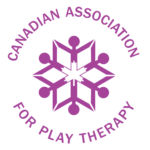Non-directive Play Therapy and Filial Therapy
Overview:
Non-Directive Play Therapy is the most prominent model of play therapy. Child-centered play therapy was developed by Virginia Axline based on the principles Client-Centered Therapy by Carl Rogers. Its premise is that if a therapist creates a safe therapeutic environment a child will initiate the therapeutic work they need to do to resolve presenting issues. It is an evidence-based therapeutic intervention for children ages 3-12 and older.
Play is a child’s natural medium of communication, symbolic language. Play serves important child developmental purposes including motor, social, emotional, intellectual and mastery. Play represents the child’s attempt to organize and integrate their experiences and internal world. It is by expressing, through play – the process of externalizing the images and symbols from the inner world, through a creative medium that is witnessed in sensory form and honoured by a skilled and trained therapist who is fully present – that a deeper level of growth and healing occur. Child-Centered Play Therapy is an empirically supported approach that helps children express feelings, heal trauma, develop emotional regulation and problem-solving skills, and enhance self- esteem.
Filial Therapy is a highly effective empirically-supported intervention integrating family therapy and play therapy to address child and family problems. Therapists learn how to train and supervise parents as they conduct special child-centered play sessions with their own children, an approach designed to resolve presenting problems while strengthening family relationships. It facilitates positive and long-lasting child and family change. Filial therapy has been used in many different settings and has been embraced by many cultural and ethnic groups throughout the world because of its respectful involvement of parents as partners in the process of family change.
Learning Outcomes:
- Participants will be able to:
- describe language as images in a child’s play;
- describe the role of play in child development;
- identify Virginia Axline’s principles of child-centered play therapy;
- identify the goals, stages, and intake, assessment and treatment process;
- confidently and effectively recommend child-centered play therapy to parents as the most appropriate therapeutic intervention;
- demonstrate child-centered play therapy skills with competence and confidence;
- describe appropriate playroom setup and toy selection and rationale;
- explain to parents the value and importance of play and their involvement in their children’s treatment;
- teach the 4 child-centered play skills to parents using practice mock play sessions;
- observe parent-child play sessions and provide constructive feedback to parents to improve their skills;


Non-directive Play Therapy and Filial Therapy
Overview:
Non-Directive Play Therapy is the most prominent model of play therapy. Child-centered play therapy was developed by Virginia Axline based on the principles Client-Centered Therapy by Carl Rogers. Its premise is that if a therapist creates a safe therapeutic environment a child will initiate the therapeutic work they need to do to resolve presenting issues. It is an evidence-based therapeutic intervention for children ages 3-12 and older.
Play is a child’s natural medium of communication, symbolic language. Play serves important child developmental purposes including motor, social, emotional, intellectual and mastery. Play represents the child’s attempt to organize and integrate their experiences and internal world. It is by expressing, through play – the process of externalizing the images and symbols from the inner world, through a creative medium that is witnessed in sensory form and honoured by a skilled and trained therapist who is fully present – that a deeper level of growth and healing occur. Child-Centered Play Therapy is an empirically supported approach that helps children express feelings, heal trauma, develop emotional regulation and problem-solving skills, and enhance self- esteem.
Filial Therapy is a highly effective empirically-supported intervention integrating family therapy and play therapy to address child and family problems. Therapists learn how to train and supervise parents as they conduct special child-centered play sessions with their own children, an approach designed to resolve presenting problems while strengthening family relationships. It facilitates positive and long-lasting child and family change. Filial therapy has been used in many different settings and has been embraced by many cultural and ethnic groups throughout the world because of its respectful involvement of parents as partners in the process of family change.
Learning Outcomes:
- Participants will be able to:
- describe language as images in a child’s play;
- describe the role of play in child development;
- identify Virginia Axline’s principles of child-centered play therapy;
- identify the goals, stages, and intake, assessment and treatment process;
- confidently and effectively recommend child-centered play therapy to parents as the most appropriate therapeutic intervention;
- demonstrate child-centered play therapy skills with competence and confidence;
- describe appropriate playroom setup and toy selection and rationale;
- explain to parents the value and importance of play and their involvement in their children’s treatment;
- teach the 4 child-centered play skills to parents using practice mock play sessions;
- observe parent-child play sessions and provide constructive feedback to parents to improve their skills;
